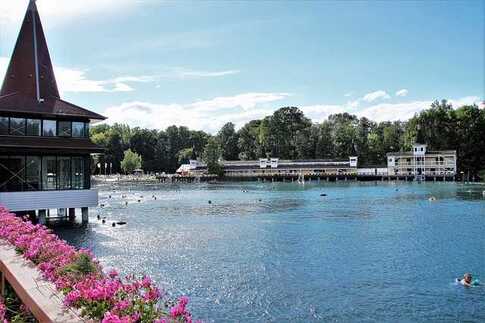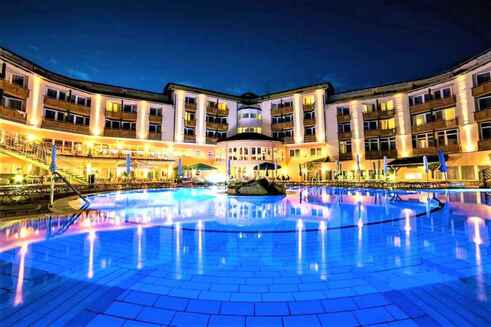Hungary is a popular tourist destination due to its thousand-year fascinating history, culture, traditions, wonderful sights, old villages, charming towns, stunning architecture, luxurious castles, amazing scenery, beautiful nature, lakes, rivers, delicious cuisine and wine.
This centre located country in Europe offers various outdoor activities, recreation facilities, spas, wellness and medical resorts where visitors receive excellent service.
1. Hungary is one of the richest countries of the thermal water in the world
Discover the thermal waters of Hungary! Explore the best thermal baths in the country. It's worth to try. There are more than 1500 thermal water springs, including 123 in Budapest, and over 270 different types of mineral and medical waters.
You will have a perfect opportunity to bathe in the spa all over the country year-round. Hungarian thermal water is an integral part of national culture and plays the important role in the daily life of Hungarian citizens.
You will have a perfect opportunity to bathe in the spa all over the country year-round. Hungarian thermal water is an integral part of national culture and plays the important role in the daily life of Hungarian citizens.
2. The history of bathing in Hungary dates back thousands of years
Hungary was a part of the Roman Empire for a relatively long period from the 1st to 4th centuries. Bathing was a very important part of the Roman lifestyle. People came to the bathhouse not only for their hygiene and cleaning but also to socialize there.
During the Ottoman Era in Hungary (1541-1699), Turks brought their bathing tradition and merged it with Roman ones. Turkish-style bathhouses were created. The treatment includes hot steam, special olive soap, massage, and oils. Turks valued bathing as a hygiene maintenance, relaxation, and social gathering as well.
The bathhouses became very popular among the Hungarian people. The bath culture started spreading across the Hungary during 16th and 17th centuries. Existing spas were built mainly in the 19th and 20th centuries.
During the Ottoman Era in Hungary (1541-1699), Turks brought their bathing tradition and merged it with Roman ones. Turkish-style bathhouses were created. The treatment includes hot steam, special olive soap, massage, and oils. Turks valued bathing as a hygiene maintenance, relaxation, and social gathering as well.
The bathhouses became very popular among the Hungarian people. The bath culture started spreading across the Hungary during 16th and 17th centuries. Existing spas were built mainly in the 19th and 20th centuries.
Photo source: Lotus Terme Hotel & Spa
3. Hungarian natural resources have curative properties
Hungary is rich in natural resources such as thermal water, medical mud, and climate with a proven healing effect.
- Healing thermal water
Hungary is well-known for its thermal and mineral water resources. There are not other country in the world where nearly 80% of the country's territory has thermal waters underground. Hungary's thermal-water resources are world-class in terms of their quantity, quality, and usability.
The knowledge of the healing powers of waters was based on experiences. Spas are beneficial in recreation, restoring physical and mental health. However, scientific researches of balneotherapy started in the middle of the 19th century. Published scientific articles confirmed that Hungarian thermal mineral waters significantly reduce pain in degenerative joint, spinal disease, osteoarthritis of the hand and knee, reduce chronic low back pain, helps soothe sore muscles, fight inflammation, improve circulation, and promote a natural radiance comes from within.
Temperature of water vary from 30 to 99 degree Celsius. Different types of mineral-rich water are found in Hungary, including carbonated, earthy-limey, alkaline, chloride, sodium-chloride, sulphurous, iodine-bromine, and radioactive. The chemistry of hot springs varies and depends on valuable mineral content dissolved there. These minerals are absorbed through the skin while bathing. Some medicinal waters are used for a drink or inhalation.
There are 260 public baths and spas currently in operation in the country. 89 of these spas have waters classified as a medical, and 140 as mineral. The Hungarian standards on medical water are stricter than elsewhere in the world.
Hungary is well-known for its thermal and mineral water resources. There are not other country in the world where nearly 80% of the country's territory has thermal waters underground. Hungary's thermal-water resources are world-class in terms of their quantity, quality, and usability.
The knowledge of the healing powers of waters was based on experiences. Spas are beneficial in recreation, restoring physical and mental health. However, scientific researches of balneotherapy started in the middle of the 19th century. Published scientific articles confirmed that Hungarian thermal mineral waters significantly reduce pain in degenerative joint, spinal disease, osteoarthritis of the hand and knee, reduce chronic low back pain, helps soothe sore muscles, fight inflammation, improve circulation, and promote a natural radiance comes from within.
Temperature of water vary from 30 to 99 degree Celsius. Different types of mineral-rich water are found in Hungary, including carbonated, earthy-limey, alkaline, chloride, sodium-chloride, sulphurous, iodine-bromine, and radioactive. The chemistry of hot springs varies and depends on valuable mineral content dissolved there. These minerals are absorbed through the skin while bathing. Some medicinal waters are used for a drink or inhalation.
There are 260 public baths and spas currently in operation in the country. 89 of these spas have waters classified as a medical, and 140 as mineral. The Hungarian standards on medical water are stricter than elsewhere in the world.
- Medical mud
Healing mud is mineral-rich has many benefits in treatment of a full range of illnesses. depending on the specific composition of elements such as bromine, sulphur, magnesium, etc. Mud therapy is great remedies for musculoskeletal disorder and skin diseases. Warm mud with temperature 36-42°C is used for the packs. The therapeutic treatment with mud has a long-lasting effect, easing pains and aches for several months.
- Therapeutic climate
There are five certified medicinal caves in Hungary. Cave therapy is based on therapeutic climate effects. Healing air in the cave provides improvement for various respiratory diseases.
Healing mud is mineral-rich has many benefits in treatment of a full range of illnesses. depending on the specific composition of elements such as bromine, sulphur, magnesium, etc. Mud therapy is great remedies for musculoskeletal disorder and skin diseases. Warm mud with temperature 36-42°C is used for the packs. The therapeutic treatment with mud has a long-lasting effect, easing pains and aches for several months.
- Therapeutic climate
There are five certified medicinal caves in Hungary. Cave therapy is based on therapeutic climate effects. Healing air in the cave provides improvement for various respiratory diseases.
4. Spa resorts offer variety of health and wellness packages
Hungary attracts people who care about their health and well-being. They travel to the country to maintain good health, rejuvenate and refresh body, mine, and soul.
Many travelers visit Hungary for an alternative treatment to prevent diseases or threat health disorders. Medical centers and spas are built around medicinal springs. The health spa hotels provide a variety of treatments that utilize healing natural resources. Hungarian clinics also are well-known for their dentistry, ophthalmology, diagnostics, and plastic surgery.
Are you ready to book healing spa treatment? Click here to select right package.
Many travelers visit Hungary for an alternative treatment to prevent diseases or threat health disorders. Medical centers and spas are built around medicinal springs. The health spa hotels provide a variety of treatments that utilize healing natural resources. Hungarian clinics also are well-known for their dentistry, ophthalmology, diagnostics, and plastic surgery.
Are you ready to book healing spa treatment? Click here to select right package.
5. Spa capital
Budapest is famous as the "Spa Capital of Europe" where 123 springs provide 70 million litres of thermal water per day. There are 15 public spas and numerous private thermal spas at some luxurious hotels.
One of the oldest spas and most beautiful bathhouses in Budapest is the Szechenyi Thermal Bath. It is also one of the largest spa complexes in Europe. The thermal bath was built in 1913 and expanded in 1927. The most famous Budapest spa offers great selection of 15 indoor and 3 outside thermal water pools, various temperature steam rooms, and saunas.
It is hard to believe, but the three oldest Turkish baths, Veli Bej, Rudas, and Kiraly, are still in use today. Rudas bathhouse offers medical thermal water for curative treatments.
One of the oldest spas and most beautiful bathhouses in Budapest is the Szechenyi Thermal Bath. It is also one of the largest spa complexes in Europe. The thermal bath was built in 1913 and expanded in 1927. The most famous Budapest spa offers great selection of 15 indoor and 3 outside thermal water pools, various temperature steam rooms, and saunas.
It is hard to believe, but the three oldest Turkish baths, Veli Bej, Rudas, and Kiraly, are still in use today. Rudas bathhouse offers medical thermal water for curative treatments.
References
1. Evidence-based Hydro- and Balneotherapy in Hungary - a Systematic Review and Meta-analysis
2. The role of Thermal Water in Chronic Skin Diseases Management: a Review of the Literature
3. Balneotherapy in Medicine and Dentistry: a Review
1. Evidence-based Hydro- and Balneotherapy in Hungary - a Systematic Review and Meta-analysis
2. The role of Thermal Water in Chronic Skin Diseases Management: a Review of the Literature
3. Balneotherapy in Medicine and Dentistry: a Review








